
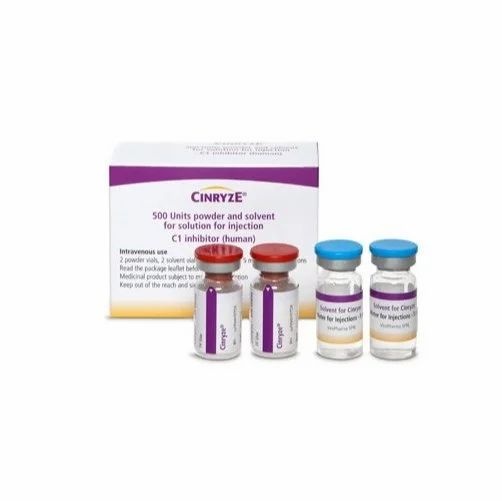
ЦИНРИЗ 500 ОДИНИЦЬ Порошок і розчинник для приготування розчину для ін'єкцій

Запитайте лікаря про рецепт на ЦИНРИЗ 500 ОДИНИЦЬ Порошок і розчинник для приготування розчину для ін'єкцій

Інструкція із застосування ЦИНРИЗ 500 ОДИНИЦЬ Порошок і розчинник для приготування розчину для ін'єкцій
Вступ
Опис: інформація для користувача
Cinryze 500 ОД порошок і розчинник для ін'єкційного розчину
інгібітор гуманої естерази С1
Всімістно прочитайте цей опис перед початком використання цього лікарського засобу, оскільки він містить важливу інформацію для вас.
- Збережіть цей опис, оскільки вам може знадобитися знову його прочитати.
- Якщо у вас виникли питання, проконсультуйтеся з вашим лікарем або фармацевтом.
- Цей лікарський засіб призначений тільки для вас, і не слід давати його іншим людям, навіть якщо вони мають相同ні симптоми, оскільки це може їм нашкодити.
- Якщо ви відчуваєте побічні ефекти, проконсультуйтеся з вашим лікарем або фармацевтом, навіть якщо це побічні ефекти, які не вказані в цьому описі. Див. розділ 4.
Зміст опису
- Що таке Cinryze і для чого він використовується
- Що вам потрібно знати перед початком використання Cinryze
- Як використовувати Cinryze
- Можливі побічні ефекти
- Збереження Cinryze
- Зміст упаковки та додаткова інформація
1. Що таке Cinryze і для чого він використовується
Cinryze містить білок людини, званий "інгібітор естерази С1", як активну речовину.
Інгібітор естерази С1 - це білок, який виробляється природним шляхом і зазвичай присутній у крові. Якщо рівень інгібітора естерази С1 у крові низький або інгібітор естерази С1 не функціонує належним чином, це може призвести до епізоду набухання (званого ангіоневротичним набуханням). Симптоми можуть включати болі в животі та набухання:
- рук та ніг
- обличчя, повік, губ або язика
- горла, що може зробити важким дихання
- геніталій
У дорослих і дітей Cinryze може збільшити кількість інгібітора естерази С1 у крові та попередити (до проведення медичного або стоматологічного процедури) розвиток цих епізодів набухання або зупинити їх після початку.
У дорослих, підлітків і дітей (від 6 років і старше) Cinryze може збільшити кількість інгібітора естерази С1 у крові та попередити регулярно розвиток епізодів набухання.
2. Що вам потрібно знати перед початком використання Cinryze
Не використовуйте Cinryze
- якщо ви алергічні на інгібітор естерази С1 людини або на будь-який інший компонент цього лікарського засобу (перелічені у розділі 6). Важливо, щоб ви повідомили вашому лікареві, якщо ви вважаєте, що мали будь-коли алергічну реакцію на будь-який компонент Cinryze.
Попередження та застереження
- Перед початком лікування Cinryze важливо, щоб ви повідомили вашому лікареві, якщо у вас є або були проблеми з згортанням крові (тромботичні події). У цьому випадку вас буде підданий інтенсивному спостереженню.
- Якщо ви починаєте відчувати шкірні висипи, стиск у грудній клітці, свистячий дихання або швидке серцебиття після використання Cinryze, повідомте вашому лікареві негайно. Див. розділ 4.
- Під час виготовлення лікарських засобів з людської крові чи плазми потрібно вживати певні заходи для попередження передачі інфекцій пацієнтам. Серед цих заходів є ретельний відбір донорів плазми та крові для забезпечення виключення осіб з ризиком бути носіями інфекцій, а також аналіз кожної донованої крові та плазми для виявлення ознак вірусів/інфекцій. Виробники цих продуктів також включають заходи під час обробки крові чи плазми, які можуть інактивувати та/або усунути віруси. Незважаючи на ці заходи, при введенні лікарських засобів, виготовлених з людської крові чи плазми, не можна повністю виключити можливість передачі інфекції. Це також застосовується до невідомих або нових вірусів, або інших типів інфекцій.
- Заходи, які приймаються, вважаються ефективними для вірусів з оболонкою, таких як ВІЛ, вірус гепатиту Б і вірус гепатиту С, а також для невірусних гепатиту А і парвовірусу В19.
- Ваш лікар може порекомендувати вам розглянути можливість вакцинації проти гепатиту А і Б, якщо ви регулярно або повторно приймаєте продукти інгібітора естерази С1 людини, виготовлені з людської плазми.
- Для покращення відстеження біологічних лікарських засобів лікар або медсестра повинні чітко реєструвати назву та номер партії лікарського засобу, який вводиться.
Діти
Cinryze не повинен використовуватися у дітей молодших 6 років для регулярної профілактики кризів ангіоневротичного набухання.
Використання Cinryze зіншими лікарськими засобами
Повідомте вашому лікареві, якщо ви використовуєте, нещодавно використовували або можете використовувати будь-який інший лікарський засіб.
Вагітність і лактація
Якщо ви вагітні або перебуваєте у період лактації, вважаєте, що можете бути вагітні або плануєте вагітність, проконсультуйтеся з вашим лікарем перед використанням цього лікарського засобу. Інформація про безпеку використання Cinryze у вагітних жінок та під час лактації обмежена. Ваш лікар повідомить вам про ризики та переваги використання цього лікарського засобу.
Водіння транспортних засобів і використання машин
Вплив Cinryze на здатність водити транспортні засоби та використовувати машини незначний.
Cinryze містить натрій
Цей лікарський засіб містить 11,5 мг натрію (основного компонента кухонної солі) у кожній флаконі. Це становить 0,5% від максимальної добової норми споживання натрію, рекомендованої для дорослих.
3. Як використовувати Cinryze
Ваше лікування буде розпочато і контролюватися під наглядом лікаря, який має досвід у лікуванні пацієнтів з ангіоневротичним набуханням (АЕН).
Ваш лікар або медсестра можуть підготувати та ввести ін'єкцію Cinryze. Якщо ваш лікар вирішить, що ви можете самостійно вводити лікарський засіб, ваш лікар або медсестра навчить вас або члена вашої сім'ї підготувати та ввести Cinryze. Ваш лікар періодично переглядатиме процес підготування та введення з вами або з членом вашої сім'ї чи опікуном.
Рекомендована доза Cinryze для дорослих, підлітків, дітей, осіб похилого віку або пацієнтів з проблемами печінки чи нирок наступна:
Використання у дорослих і підлітків (від 12 років і старше)
Лікування епізодів набухання
- Вам потрібно ввести дозу 1 000 ОД (два флакони) Cinryze при появі першого ознаки епізоду набухання.
- Можна ввести другу ін'єкцію 1 000 ОД, якщо симптоми не покращили після 60 хвилин.
- Якщо у вас розвивається тяжкий епізод, особливо набухання горла (голосової щілини), або якщо лікування затримується, можна ввести другу дозу 1 000 ОД до закінчення 60 хвилин після першої дози, залежно від вашої клінічної реакції.
- Cinryze вводиться внутрішньовенно (у вену).
Регулярна профілактика епізодів набухання
- Вам потрібно ввести дозу 1 000 ОД (два флакони) Cinryze кожні 3 або 4 дні для регулярної профілактики епізодів набухання.
- Ваш лікар може регулювати інтервал введення залежно від вашої реакції на Cinryze.
- Cinryze вводиться внутрішньовенно (у вену).
Допередопераційна профілактика епізодів набухання
- Вам потрібно ввести дозу 1 000 ОД (два флакони) Cinryze до 24 годин перед медичним, стоматологічним або хірургічним втручанням.
- Cinryze вводиться внутрішньовенно (у вену).
Використання у дітей
Лікування кризів ангіоневротичного набухання | Допередопераційна профілактика кризів ангіоневротичного набухання | Регулярна профілактика кризів ангіоневротичного набухання |
2-11 років, > 25кг: Вам потрібно ввести дозу 1 000 ОД (два флакони) Cinryze при появі першого ознаки епізоду набухання. Можна ввести другу ін'єкцію 1 000 ОД, якщо симптоми не покращили після 60 хвилин. 2-11 років, 10-25кг: Вам потрібно ввести дозу 500 ОД (один флакон) Cinryze при появі першого ознаки епізоду набухання. Можна ввести другу ін'єкцію 500 ОД, якщо симптоми не покращили після 60 хвилин. | 2-11 років, > 25кг: Вам потрібно ввести дозу 1 000 ОД (два флакони) Cinryze до 24 годин перед медичним, стоматологічним або хірургічним втручанням. 2-11 років, 10-25кг: Вам потрібно ввести дозу 500 ОД (один флакон) Cinryze до 24 годин перед медичним, стоматологічним або хірургічним втручанням. | 6-11 років: Вам потрібно ввести дозу 500 ОД (один флакон) Cinryze кожні 3 або 4 дні для регулярної профілактики епізодів набухання. Ваш лікар може регулювати інтервал введення залежно від вашої реакції на Cinryze. |
Реконструкція та форма введення
Зазвичай ваш лікар або медсестра вводитиме ін'єкцію Cinryze у вену (внутрішньовенно). Ви або ваш опікун також можете самостійно вводити Cinryze, але лише після відповідної підготовки. Якщо ви вводите Cinryze самостійно, завжди слідуйте інструкціям вашого лікаря точно. У разі сумнівів запитайте у вашого лікаря. Якщо ваш лікар вирішить, що ви можете отримувати лікування вдома, він надасть вам детальні інструкції. Вам буде запропоновано вести щоденник для документування кожного проведеного лікування вдома та приносити його на кожному прийомі у лікаря. Ви/ваш опікун будете періодично проходити перевірку техніки ін'єкції, щоб переконатися, що ви правильно обробляєте лікарський засіб.
Якщо у вас є будь-які інші питання щодо використання цього лікарського засобу, запитайте у вашого лікаря або фармацевта.
4. Можливі побічні ефекти
Як і всі лікарські засоби, цей лікарський засіб може викликати побічні ефекти, хоча не всі люди їх відчувають.
Це може включати алергічні реакції.
Повідомте вашому лікареві негайно, якщо ви відчуваєте будь-які з наступних симптомів після використання цього лікарського засобу. Хоча це рідко, симптоми можуть бути серйозними.
Раптове свистяче дихання, труднощі з диханням, набухання повік, обличчя, губ або язика, шкірні висипи або свербіж (особливо коли вони впливають на все тіло).
Дуже часті побічні ефекти (можуть виникнути у більше 1 з 10 осіб): головний біль, нудота.
Часті побічні ефекти (можуть виникнути у до 1 з 10 осіб): гіперчутливість, головокружіння, блювота, шкірні висипи, свербіж або червоність, висипи або біль у місці ін'єкції, гарячка.
Рідкі побічні ефекти (можуть виникнути у до 1 з 100 осіб): високий рівень цукру у крові, кров'яні згустки, біль у венах, приховування, кашель, біль у животі, діарея, лущення шкіри, набухання та біль у суглобах, біль у м'язах та грудній клітці.
Чекається, що побічні ефекти у дітей та підлітків будуть подібні до тих, що спостерігаються у дорослих.
Повідомлення про побічні ефекти
Якщо ви відчуваєте будь-які побічні ефекти, повідомте вашому лікареві або медсестрі, навіть якщо це побічні ефекти, які не вказані в цьому описі. Ви також можете повідомити про них безпосередньо через національну систему повідомлень, вказану в додатку V. Повідомляючи про побічні ефекти, ви можете допомогти надати більше інформації про безпеку цього лікарського засобу.
5. Збереження Cinryze
Тримайте цей лікарський засіб поза зоною досяжності дітей.
Не використовуйте цей лікарський засіб після закінчення терміну придатності, вказаного на коробці та флаконах після "CAD".
Тримайте при температурі нижче 25 °C. Не заморожуйте. Тримайте в оригінальній упаковці, щоб захистити від світла.
Після реконструкції розчин Cinryze потрібно використовувати негайно.
Лікарські засоби не повинні викидатися у каналізацію або сміття. Запитайте у вашого фармацевта, як позбутися упаковок та лікарських засобів, які вам більше не потрібні. Таким чином, ви допоможете захистити навколишнє середовище.
6. Зміст упаковки та додаткова інформація
СкладЦинрізе
Активний інгредієнт - інгібітор естерази С1 людини, виготовлений з плазми донорів людини. Кожна флакон порошку містить 500 ОД інгібітора естерази С1 людини. Після відновлення один флакон містить 500 ОД інгібітора естерази С1 людини на 5 мл, що відповідає концентрації 100 ОД/мл. Два флакони відновленого Цинрізе містять 1000 ОД інгібітора естерази С1 людини на 10 мл, що відповідає концентрації 100 ОД/мл.
Загальний вміст білка в відновленому розчині становить 15 ± 5 мг/мл.
Одна міжнародна одиниця (ОД) відповідає кількості інгібітора естерази С1, присутнього в 1 мл нормальної людської плазми.
Інші компоненти - хлорид натрію, сукроза, цитрат натрію, Л-валін, Л-аланін і Л-треонін (див. розділ 2).
Розчинник: вода для ін'єкцій.
Вигляд продукту та вміст упаковки
Порошок і розчинник для ін'єкційного розчину.
Цинрізе - білий порошок, який поставляється у флаконі.
Після відновлення у воді для ін'єкцій розчин прозорий і безбарвний або легенько синій.
Кожна упаковка містить:
2 флакони Цинрізе 500 ОД порошку для ін'єкційного розчину
2 флакони води для ін'єкцій (по 5 мл кожен)
2 трансферні набори з фільтром
2 одноразові шприци на 10 мл
2 комплекти для венепункції
2 захисні ковпачки
Використовуйте лише шприц без силікону (постачається в упаковці) для введення препарату.
Власник дозволу на торгівлю та відповідальна особа за виробництво
Власник дозволу на торгівлю
Takeda Manufacturing Austria AG
Industriestrasse 67
1221 Відень
Австрія
Виробництво
Takeda Manufacturing Austria AG
Industriestrasse 67
1221 Відень
Австрія
Shire International Licensing B.V.
Mercuriusplein 11
2132 HA Hoofddorp
Нідерланди
Для отримання додаткової інформації щодо цього препарату зверніться до місцевого представника власника дозволу на торгівлю:
Бельгія Takeda Belgium NV Тел: +32 2 464 06 11 | Литва Takeda, UAB Тел: +370 521 09 070 |
| Люксембург Takeda Belgium NV Тел: +32 2 464 06 11 |
Чехія Takeda Pharmaceuticals Czech Republic s.r.o. Тел: +420 234 722 722 | Угорщина Takeda Pharma Kft. Тел: +36 1 270 7030 |
Данія Takeda Pharma A/S Тел: +45 46 77 10 10 | Мальта Τakeda HELLAS S.A. Тел: +30 210 6387800 |
Німеччина Takeda GmbH Тел: +49 (0)800 825 3325 | Нідерланди Takeda Nederland B.V. Тел: +31 20 203 5492 |
Естонія Takeda Pharma OÜ Тел: +372 6177 669 | Норвегія Takeda AS Тел: +47 800 800 30 |
Греція Τakeda ΕΛΛΑΣ Α.Ε. Тел: +30 210 6387800 | Австрія Takeda Pharma Ges.m.b.H. Тел: +43 (0) 800-20 80 50 |
Іспанія Takeda Farmacéutica España S.A. Тел: +34 917 90 42 22 | Польща Takeda Pharma Sp. z o.o. Тел: +48223062447 |
Франція Takeda France SAS Тел: + 33 1 40 67 33 00 | Португалія Takeda Farmacêuticos Portugal, Lda. Тел: + 351 21 120 1457 |
Хорватія Takeda Pharmaceuticals Croatia d.o.o. Тел: +385 1 377 88 96 | Румунія Takeda Pharmaceuticals SRL Тел: +40 21 335 03 91 |
Ірландія Takeda Products Ireland Ltd Тел: 1800 937 970 | Словенія Takeda Pharmaceuticals farmacevtska družba d.o.o. Тел: + 386 (0) 59 082 480 |
Ісландія Vistor ehf. Тел: +354 535 7000 | Словаччина Takeda Pharmaceuticals Slovakia s.r.o. Тел: +421 (2) 20 602 600 |
Італія Takeda Italia S.p.A. Тел: +39 06 502601 | Фінляндія Takeda Oy Тел: 0800 774 051 |
Кіпр Τakeda ΕΛΛΑΣ Α.Ε. Тел: +30 210 6387800 | Швеція Takeda Pharma AB Тел: 020 795 079 |
Латвія Takeda Latvia SIA Тел: +371 67840082 |
Дата останнього перегляду цієї інструкції:
Інші джерела інформації
Детальна інформація про цей препарат доступна на сайті Європейського агентства з лікарських засобів: https://www.ema.europa.eu. Також існують посилання на інші веб-сайти про рідкісні захворювання та орфанні препарати.
____________________________________________________________________________
Ця інформація призначена лише для медичних працівників:
Відновлення та введення Цинрізе
Відновлення, введення препарату та обробка обладнання для введення та голок повинні проводитися з обережністю.
Використовуйте трансферний набір з фільтром, який постачається з Цинрізе, або голку з двома кінцями, доступну в торгівлі.
Використовуйте лише шприц без силікону (постачається в упаковці) для введення препарату.
Підготовка та обробка
Цинрізе призначений для внутрішньовенної ін'єкції (введення в вену) після відновлення у воді для ін'єкцій.
Флакон Цинрізе призначений лише для одного використання.
Відновлення
Для дози 500 ОД: потрібно 1 флакон порошку, 1 флакон розчинника, 1 трансферний набір з фільтром, 1 шприц на 10 мл, 1 комплект для венепункції та 1 захисний ковпачок. Збережіть флакон та обладнання для введення для наступної дози.
Для дози 1000 ОД: потрібно 2 флакони порошку, 2 флакони розчинника, 2 трансферні набори з фільтром, 1 шприц на 10 мл, 1 комплект для венепункції та 1 захисний ковпачок.
Кожен флакон препарату повинен бути відновлений 5 мл води для ін'єкцій.
Один флакон відновленого Цинрізе відповідає дозі 500 ОД. Тому відновіть лише один флакон Цинрізе для дози 500 ОД.
Два флакони відновленого Цинрізе відповідають дозі 1000 ОД. Тому для дози 1000 ОД потрібно поєднати два флакони.
- Працюйте над захисним ковпачком, який постачається, та вимийте руки перед проведенням наступних процедур.
- Використовуйте асептичну техніку під час процедури відновлення.
- Перевірте, щоб флакон порошку та флакон розчинника були при кімнатній температурі (15 °C - 25 °C).
- Видаліть етикетку з флакону порошку, знімаючи фіолетову смугу, яка вказує на стрілку.
- Видаліть упаковку з флаконів порошку та розчинника.
- Витріть пробки тувалетом та дайте їм висохнути перед використанням.
- Видаліть упаковку з верхньої частини контейнера трансферного набору. Не видаліть пристрій з контейнера.
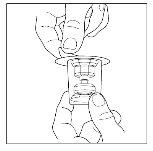
- Примітка: трансферний набір повинен бути підключений до флакону розчинника перед підключенням до флакону порошку, щоб не втратити вакуум у флаконі порошку. Поставте флакон розчинника на плоску поверхню та вставте синій кінець трансферного набору у флакон розчинника, натискаючи його всередину до тих пір, поки точка не проникне через центр пробки флакону розчинника, а пристрій не займе своє місце. Трансферний набір повинен бути вертикальним перед проникненням пробки.
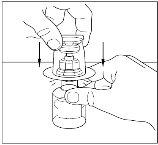
- Видаліть упаковку з трансферного набору та викиньте її. Будьте обережні, щоб не торкнутися відкритого кінця трансферного набору.
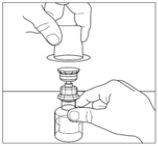
- Поставте флакон порошку на плоску поверхню. Переверніть трансферний набір та флакон розчинника, який містить воду для ін'єкцій, та вставте прозорий кінець трансферного набору у флакон порошку, натискаючи його всередину до тих пір, поки точка не проникне через гумову пробку, а трансферний набір не займе своє місце. Трансферний набор повинен бути вертикальним перед проникненням пробки флакону порошку. Вакуум флакону порошку витягне розчинник. Якщо флакон не має вакууму, не використовуйте препарат.
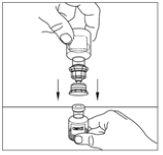
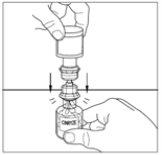
- Обережно перемістіть флакон порошку, поки він не буде добре розчинений. Не агітуйте флакон порошку. Перевірте, щоб весь порошок був добре розчинений.
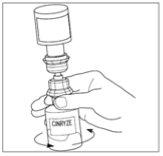
- Відключіть флакон розчинника, повертаючи його вліво. Не витягуйте прозорий кінець трансферного набору з флакону порошку.
Один флакон відновленого Цинрізе містить 500 ОД інгібітора естерази С1 людини в 5 мл, що відповідає концентрації 100 ОД/мл. Перейдіть до процесу введення, якщо пацієнти отримують дозу 500 ОД.
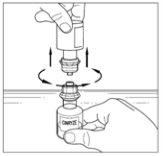
Для отримання дози 1000 ОД потрібно відновити два флакони порошку Цинрізе. Тому потрібно повторити кроки 1-12 вище, використовуючи новий контейнер з трансферним набором для відновлення другого флакону порошку. Не повторно використовуйте той же трансферний набір. Як тільки два флакони будуть відновлені, перейдіть до процесу введення для дози 1000 ОД.
Процес введення для дози 500 ОД
- Ви повинні використовувати асептичну техніку під час процедури введення.
- Після відновлення розчини Цинрізе безбарвні чи легенько сині та прозорі. Не використовуйте препарат, якщо розчини є мутними чи забарвленими.
- З використанням стерильного та одноразового шприца на 10 мл, потягніть поршень, щоб приблизно 5 мл повітря ввійшло в шприц.
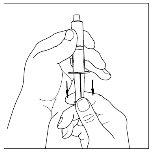
- Підключіть шприц до верхньої частини прозорого кінця трансферного набору, повертаючи його праворуч.
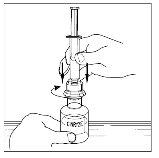
- Обережно переверніть флакон та ввійдіть повітря в розчин, а потім повільно витягніть відновлений розчин Цинрізе в шприц.
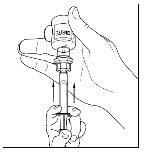
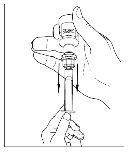
- Відключіть шприц від флакону, повертаючи його вліво та звільняючи його від прозорого кінця трансферного набору.

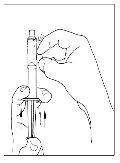
- Перед введенням, перевірте відновлений розчин Цинрізе на наявність частинок. Не використовуйте препарат, якщо ви побачите частинки.
- Підключіть комплект для венепункції до шприца, який містить розчин Цинрізе, та введіть ін'єкцію внутрішньовенно (в вену) пацієнту. Введіть 500 ОД (відновлені в 5 мл води для ін'єкцій) Цинрізе внутрішньовенно з швидкістю 1 мл на хвилину протягом 5 хвилин.
Процес введення для дози 1000 ОД
- Ви повинні використовувати асептичну техніку під час процедури введення.
- Після відновлення розчини Цинрізе безбарвні чи легенько сині та прозорі. Не використовуйте препарат, якщо розчини є мутними чи забарвленими.
- З використанням стерильного та одноразового шприца на 10 мл, потягніть поршень, щоб приблизно 5 мл повітря ввійшло в шприц.
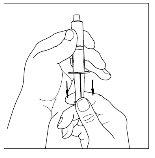
- Підключіть шприц до верхньої частини прозорого кінця трансферного набору, повертаючи його праворуч.
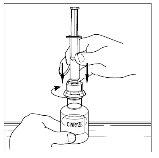
- Обережно переверніть флакон та ввійдіть повітря в розчин, а потім повільно витягніть відновлений розчин Цинрізе в шприц.
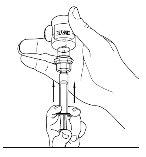
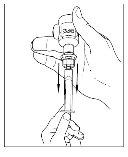
- Відключіть шприц від флакону, повертаючи його вліво та звільняючи його від прозорого кінця трансферного набору.
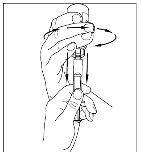
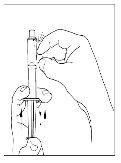
- Використовуючи той же шприц, повторіть кроки 3-6 для другого флакону відновленого Цинрізе, щоб зробити повну дозу 10 мл.
- Перед введенням, перевірте відновлений розчин Цинрізе на наявність частинок. Не використовуйте препарат, якщо ви побачите частинки.
- Підключіть комплект для венепункції до шприца, який містить розчин Цинрізе, та введіть ін'єкцію внутрішньовенно (в вену) пацієнту. Введіть 1000 ОД (відновлені в 10 мл води для ін'єкцій) Цинрізе внутрішньовенно з швидкістю 1 мл на хвилину протягом 10 хвилин.
Видалення невикористаного препарату та всіх матеріалів, які були в контакті з ним, повинно проводитися згідно з місцевими правилами.
- Країна реєстрації
- Діючі речовини
- Потрібен рецептТак
- Виробник
- Інформація є довідковою і не є медичною порадою. Перед прийомом будь-яких препаратів обов'язково проконсультуйтеся з лікарем. Oladoctor не несе відповідальності за медичні рішення, прийняті на основі цього контенту.
- Альтернативи до ЦИНРИЗ 500 ОДИНИЦЬ Порошок і розчинник для приготування розчину для ін'єкційФорма випуску: РОЗЧИН ДЛЯ ІН'ЄКЦІЙ, 1500 МОДіючі речовини: c1-inhibitor, plasma derivedВиробник: Csl Behring GmbhПотрібен рецептФорма випуску: РОЗЧИН ДЛЯ ІН'ЄКЦІЙ, 2000 МОДіючі речовини: c1-inhibitor, plasma derivedВиробник: Csl Behring GmbhПотрібен рецептФорма випуску: РОЗЧИН ДЛЯ ІН'ЄКЦІЙ, 3000 МОДіючі речовини: c1-inhibitor, plasma derivedВиробник: Csl Behring GmbhПотрібен рецепт
Аналоги ЦИНРИЗ 500 ОДИНИЦЬ Порошок і розчинник для приготування розчину для ін'єкцій в інших країнах
Найкращі аналоги з тією самою діючою речовиною та терапевтичним ефектом.
Аналог ЦИНРИЗ 500 ОДИНИЦЬ Порошок і розчинник для приготування розчину для ін'єкцій у Польща
Аналог ЦИНРИЗ 500 ОДИНИЦЬ Порошок і розчинник для приготування розчину для ін'єкцій у Україна
Лікарі онлайн щодо ЦИНРИЗ 500 ОДИНИЦЬ Порошок і розчинник для приготування розчину для ін'єкцій
Консультація щодо дозування, побічних ефектів, взаємодій, протипоказань та поновлення рецепта на ЦИНРИЗ 500 ОДИНИЦЬ Порошок і розчинник для приготування розчину для ін'єкцій – за рішенням лікаря та згідно з місцевими правилами.















